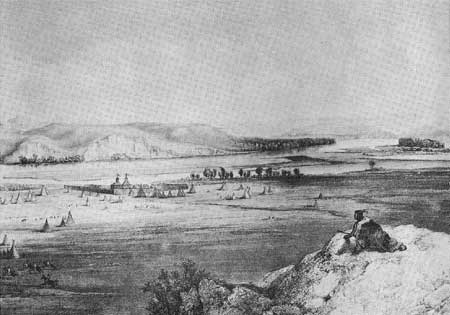|
The Upper Missouri Fur Trade Its Methods of Operation |
 |

Fort Pierre, from Bodmer
In the early period much of the taking of the furs, particularly of the beaver, was done by the white trappers. There were two classes of these, the hired trappers and the free trappers. Hired trappers were employed by the company, normally for a term of three years, for a stipulated sum. They were usually engaged for from one to two hundred dollars a year paid off in goods at company prices which were very high. [13] They performed the tasks assigned them by the company such as hunting, trapping, loading and unloading horses, mounting guard, and the distasteful duties of camp life. The company furnished their weapons, horses and equipment. [14] In 1830 the American Fur Company kept a record of the trappers and engagees employed by them. Each was briefly rated as one of the following: "a great Sulker," "a good man," "very good man," "trusty man," "worthless," "Good for Nothing," "deserted," "a Damd Rascal" and "not to be engaged." [15]
The free trappers, on the other hand, were more of an independent class. They supplied their own horses and equipment, could hunt and trap where they pleased, and could dispose of their furs to the highest bidder. Occasionally, when in dangerous country, it was necessary for the trapper to attach himself to some other trader for protection. In such circumstances he was compelled to conform to the ordinary rules for trapping and to the rules of the camp. He was also required to dispose of his beaver to the trader who commanded the camp. [16]
According to Osborne Russell, a Rocky Mountain trapper, the outfit of a trapper usually consisted of the following: "one animal upon which is placed one or two epishemores, a riding saddle and bridle, a sack containing six beaver traps, a blanket with an extra pair of moccasins, his powder horn and bullet pouch, with a belt to which is attached a butcher knife, a wooden box containing bait for beaver, a tobacco sack with a pipe and implements for making fire, with sometimes a hatchet fastened to the pommel of his saddle...." [17]
In the Rocky Mountain region, much of the beaver trapping had been done by bands of white trappers traveling fousugh the country. On the Upper Missouri, on the other hand, a large part of the trapping, particularly of the small fur-bearing animals such as muskrat, racoon, otter, and ermine was done by the Indians. The buffalo robe and a substantial tongue business, important items in the Upper Missouri trade, continued to be largely in Indian hands. With the fall in the price of beaver in the 1840's, the practice of sending large parties of white trappers fousugh the country was discontinued. Rudolph F. Kurz, who spent 1851-1852 on the Upper Missouri, wrote that in the entire North Plains Indian country "the trappers are no longer found at all." [18]
Each year the company sent out its Indian trade goods to its various posts on the Upper Missouri. Prior to the use of the steamboats in the 1830's the keelboat was largely used. Goods were shipped to the principal posts where stock valued at from fifteen to twenty thousand dollars was kept. Those shipped by the larger posts to the temporary posts varied in value from five hundred to two or three thousand dollars. The principal posts apparently stocked the staple items in large amounts. In 1831 Laidlaw reported to Pierre Chouteau Jr. that Fort Tecumseh (later replaced by Fort Pierre) had on hand 6,000 lbs. of power, 13,000 lbs. of lead and 6,000 lbs. of tobacco "and liquor a pretty good quantity" valued at $19,700.19 The most popular trade items as indicated in the inventory at Fort Union in 1831, were awls, half axes, beads, hawk bells, blankets, combs, flannel shirts, pantaloons, kettles, lead, powder, gun worms, bar iron, rifle balls, gun flints, vermillion, and coat buttons. [20] The Indians early showed a decided preference for woolen goods and guns of English manufacture. Sugar and coffee also later became popular. Whiskey, although never authorized by law and later forbidden entirely became, in spite of every effort of the government to prevent it, the principal and one of the most lucrative articles of trade. [21]

|

|
|
|
|
Last Modified: Sat, Jan 15 2005 10:00:00 am PDT |


